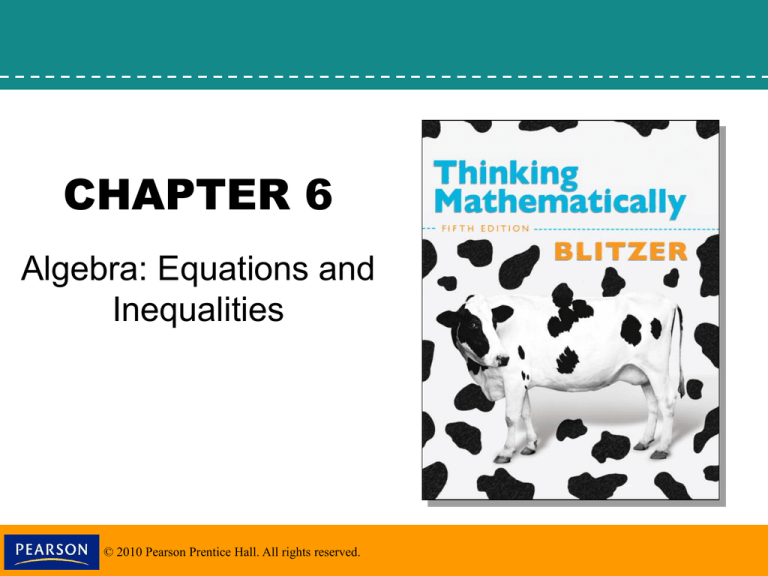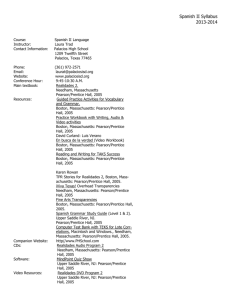
CHAPTER 6
Algebra: Equations and
Inequalities
© 2010 Pearson Prentice Hall. All rights reserved.
6.3
Applications of Linear Equations
© 2010 Pearson Prentice Hall. All rights reserved.
2
Objectives
1. Use linear equations to solve problems.
2. Solve a formula for a variable.
3
© 2010 Pearson Prentice Hall. All rights reserved.
Strategy for Solving Word Problems
Step 1 Read the problem carefully several times until you can state in
your own words what is given and what the problem is looking
for. Let x (or any variable) represent one of the quantities in the
problem.
Step 2 If necessary, write expressions for any other unknown
quantities in the problem in terms of x.
Step 3 Write an equation in x that models the verbal conditions of
the problem.
Step 4 Solve the equation and answer the problem’s question.
Step 5 Check the solution in the original wording of the problem, not
in the equation obtained from the words.
4
© 2010 Pearson Prentice Hall. All rights reserved.
Algebraic Translations of English Phrases
Addition Subtraction
Multiplication Division
sum
minus
more than
decreased by
increased by subtracted from
difference between
less than
fewer than
times
product of
percent of a number
multiplied by
twice
© 2010 Pearson Prentice Hall. All rights reserved.
divided by
quotient
reciprocal
5
Example 1: Education Pays Off
This graph shows the average yearly earnings in the United States
by highest educational attainment.
The average yearly salary of a man with an associate degree
exceeds that of a man with some college by $3 thousand. The
average yearly salary of a man with a
bachelor’s degree or more exceeds
that of a man with some college by
$41 thousand. Combined, three men
with these educational attainments
earn $188 thousand. Find the average
yearly salary of men with each of
these levels of education.
6
© 2010 Pearson Prentice Hall. All rights reserved.
Example 2: continued
Step 1: Let x represent one of the unknown
quantities.
Let x = the average yearly salary of a man with
some college.
Step 2: Represent the other unknown quantities
in terms of x.
x + 3 = the average yearly salary of a man with
an associate degree
x + 41 = the average yearly salary of a man with
a bachelor’s degree or more.
7
© 2010 Pearson Prentice Hall. All rights reserved.
Example 2: continued
Step 3: Write an equation in x that models the
conditions.
x + (x + 3) + (x + 41) = 188
Step 4: Solve the equation and answer the
question.
x ( x 3) ( x 41) 188
3 x 44 188
3 x 144
x 48
8
© 2010 Pearson Prentice Hall. All rights reserved.
Example 2: continued
The average salary with some college = 48
The average salary with an associate degree = x +
3 = 48 + 3 = 51
The average salary with a bachelor’s degree or
more = x + 41 = 48 + 41 = 89.
Some college = $48 thousand per year
Associate degree = $51 thousand
Bachelor’s degree = $89 thousand
Step 5: Check the proposed solution in the
wording of the problem. The solution checks.
9
© 2010 Pearson Prentice Hall. All rights reserved.
Example 6: Solving a Formula for One of its Variables
The total price of an article
purchased on a monthly
deferred payment plan is
described by the following
formula:
T is the total price, D is the
down payment, p is the
monthly payment, and m is
the number of months one
pays.
Solve the formula for p.
T – D = D – D + pm
T – D = pm
T – D = pm
m
m
T–D=p
m
10
© 2010 Pearson Prentice Hall. All rights reserved.












